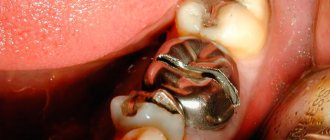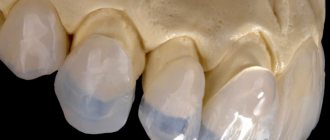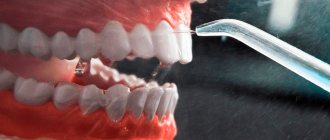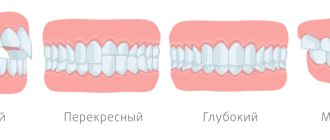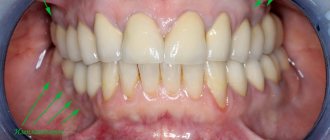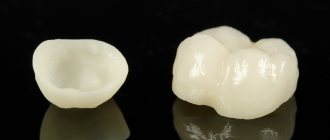Removable prosthetics Adhesive bridge Butterfly prosthesis Implant prosthetics Recommendations
The most common method of prosthetics in the absence of teeth is a bridge prosthesis. It’s just that you have to grind down the supporting teeth to fit it. And before that they are depulped (the nerve is removed). There are 2 problems here:
Psychological.
It’s already not easy to decide to go to the dentist, but the prospect of removing a nerve and grinding down teeth will force many to postpone the visit for a long time.
Dental.
Doctors do not like to depulpate teeth. There are several reasons. The pulp is full of nerve endings and blood vessels. They make the tooth alive. The blood supplies nutrients and in return the pulp produces replacement dentin. Thanks to this, teeth have the ability to restore this layer when it is damaged. Nerve endings give signals about a problem with the tooth, so caries, for example, can be diagnosed at an early stage. Without pulp, no nutrition is supplied, tissues are not renewed. The “dead tooth” becomes very fragile. It is difficult to detect infection, inflammation or caries without the pulp, because there are no nerve signals from it. The risks of losing a tooth increase.
Stages of installing a bridge
Dental prosthetics without grinding
First of all, you need to understand what “prosthetics without turning” means? As you know, when installing a single crown on a partially destroyed tooth, it must first be prepared, that is, processed using a drill and the canals healed. And this is justified due to the need to thoroughly clean the carious cavity, stopping the further development of caries. At the same time, when installing a bridge, healthy teeth are subjected to preparation; moreover, they not only have to be ground down, but also depulped - the nerves are removed from them. Thus, in order to restore one tooth, we “kill” two neighboring ones, because a tooth without a nerve is a dead tooth. It does not participate in the exchange of nutrients, therefore its fragility increases, which, coupled with the increased load that it experiences as a support for the prosthesis, leads to its destruction and loss. This is why grind-free dentures are so popular among both patients and dentists.
Prosthetics using inlays
When a tooth is very badly damaged and it is impossible to create a filling that would exactly replicate its previous shape, they resort to prosthetics using the inlay method. Previously, such a tooth inevitably had to be ground down in order to cover it with a crown, but now, thanks to inlays, the destroyed fragment of the tooth is completed without destroying it even more.
An impression is taken of the damaged tooth and its adjacent supporting teeth, from which an inlay of the desired shape will be created in the laboratory. It is created from a composite material or ceramic and will be shaped like a regular filling. Then such an inlay is cemented.
Prosthetics of anterior and chewing teeth without turning
Implantation is, of course, the most reliable and durable way to restore lost teeth without any damage to neighboring teeth. The essence of the procedure is to install a titanium pin into the jawbone, followed by prosthetics with a dental crown. The principle of the technique is based on the phenomenon of osseointegration, due to which dental implants completely fuse with the hard tissues of the jaw and become a full replacement of a living tooth in terms of functional and aesthetic parameters. The process itself takes no more than 40 minutes and is carried out under local anesthesia. During the operation, the person does not feel any discomfort, and upon completion of the implantation he is pleasantly surprised by the efficiency. The service life of implants is tens of years; one of the first patients whose teeth were restored using this technique lived with them for 45 years.
Adhesive prosthesis - temporary restoration of smile aesthetics
This version of a fixed prosthesis is a type of bridge and is especially often used for temporary prosthetics of a missing upper incisor. It will not withstand prolonged chewing load.
- It is not placed on supporting teeth, so there is no need to prepare them.
- The structure is fixed on the inner (lingual) surface of the teeth using hypoallergenic composite compounds and special technologies.
- One of the types of adhesive bridge is the so-called. beam bridge. It has a wire base, which is fixed using a composite in the recesses of the supporting teeth, which are often natural in nature. If they are absent, miniature cuts are made on the enamel, without affecting the dentin located underneath, the looser dental tissue.
The advantages of an adhesive prosthesis are the speed and low cost of production and installation: prosthetics, if necessary, can be performed literally in one visit to the dentist. There is only one thing - the prosthesis can only rest on teeth that are not affected by caries.
Bridge without turning
Prosthetics with micro-locks is a relatively new type of restoration of a lost tooth. The method is quite simple: microchannels are created in the walls of the supporting teeth, in which locks are fixed that hold the intermediate part of the bridge. The supporting teeth are not ground down or depulped (nerves are not removed). Due to the design features, bridges with micro-locks can withstand loads that far exceed the maximum possible value of chewing pressure, and the locks optimally distribute the load between the supports, eliminating pressure on the gums. However, the reliability of the system is quite questionable, and is recommended by leading dentists as a temporary structure, for example, during the healing period of an installed implant in the smile area.
Prosthetics on implants
This method is good because it can be used when one or more teeth are missing. In case of complete edentia, it is also used, but there is no talk about preparation. A metal pin is inserted into the place of the lost tooth, and dentures are put on it, without grinding the adjacent teeth.
What are the advantages:
- neighboring teeth are not affected and remain “alive”;
- the number of artificial teeth can be any;
- the method is used to restore anterior and chewing teeth;
- the implant prevents bone tissue atrophy;
- Implants come with a lifetime warranty.
For prosthetics on implants, you can use any of the following methods:
- Removable prosthetics
A removable denture is attached to part of the jaw or to the entire dentition much better than on natural teeth. Removable structures do not fall out arbitrarily, but the patient is able to remove them himself for hygiene procedures. Conditionally removable ones are secured with screws; only a dentist can remove them.
- Fixed prosthetics
The classic bridge design has proven its effectiveness. This is a reliable way to restore your teeth. When attached to implants, all the disadvantages disappear: dentures are without grinding, which means there is no need to depulpate the supporting teeth. The metal pin is stronger than the natural root, the design will last for many years. Implants prevent bone tissue from resorption. There are no restrictions in the choice of materials for crowns, and the number of artificial teeth can be more than 2
.
Unfortunately, sometimes there are contraindications to installing implants. In such cases, other prosthetic methods are used without turning adjacent teeth.
Adhesive technique for restoring teeth without grinding adjacent teeth
This technique involves fixing the prosthesis using various durable and elastic materials, including plastic and fiberglass. Adhesive bridges can be of three types, depending on the type of attachment. The most gentle method is fastening with special glue. The undoubted advantage of such fixation is its reversibility in case of refusal of the prosthesis. The other two types of adhesive bridges still require some processing of adjacent teeth, although less radical than grinding. The fastening is made of fiberglass tape, for which the doctor makes small notches on top or on the back walls of the supporting teeth. It is worth noting that adhesive structures are not reliable and can only be used as a temporary measure and exclusively for the restoration of one tooth. However, this is the most common method of dental prosthetics without grinding, prices for which in various clinics start from 3,000 rubles.
Adhesive bridge
There are no crowns in this design, therefore, there is no need to grind down the teeth. The artificial tooth is attached to its neighbors using fiberglass tape “shoots.” The tape is fixed on the inside, it is not visible. A groove is cut into the tooth for the fiberglass so that the tape does not protrude above the surface and does not interfere.
The product is not strong enough to be used on chewing teeth or as a permanent denture. Typically, such a bridge without grinding adjacent teeth is a temporary measure in preparation for permanent prosthetics or implantation. If treated with care, the structure can last up to 3 years
.
Bacteria can accumulate in the bonding areas, increasing the risk of tooth decay. The prosthesis does not distribute the chewing load well; the supporting teeth are overloaded. In addition, such orthopedics does not prevent bone atrophy.
Removable prosthetics without turning
Nylon prosthesis is the fastest and most inexpensive type of removable prosthetics. It is a structure consisting of a frame and an artificial dentition. Thanks to the thinness and flexibility of nylon, the prosthesis fits tightly around the gums and adjacent teeth, adjacent to the edge of the upper or lower palate. Nylon dentures can be used to replace a dental defect of any extent: from one or two teeth to a full jaw. However, it is worth paying attention to the significant disadvantages of this prosthetic option. The elasticity and flexibility of the prosthesis negatively affects the mucous membrane, causing accelerated atrophy and chafing. Due to changes in the topography of the oral cavity and wear of the material over time, nylon dentures require adjustment or replacement. In addition, owners of nylon prostheses experience discomfort when wearing them and are forced to regularly remove the structure for special cleaning and treatment.
Features of frontal prostheses
If the front tooth has significant damage to the vestibular surface that cannot be restored with filling materials, an excellent solution is ceramic onlays or lumineers. These dental products are so thin that even when applied to an unprepared tooth, they practically do not distort its dimensions, but the front surface acquires a natural appearance without losing the smooth transition of color from dark, in the gum area, to a slightly lighter incisal edge. Lumineers are an excellent alternative to completely replacing a tooth with an artificial prosthesis, since such frontal petal overlays are highly colorfast and do not require special care.
Another option for prosthetics is used when removing one front tooth, in the place of which is most often a lateral incisor or first premolar (dentists call it a “four”). The essence of the method is that a strip of material similar to fiberglass is glued to the back surface of the dentition units adjacent to the defective tooth, and if such a strip is impregnated with a special composite filling material, it becomes rigid and strong, so that an artificial tooth can be glued to it .
In addition, if one front tooth is lost, a small removable denture can be made, placed on the gum and held by the adjacent teeth using special devices - clasps. These structures can be either metal or less noticeable - plastic, although in this case the clasps are not attached to the teeth, but are applied to the gums and are called pelots.
Conclusion: possibilities for prosthetics of the anterior row of teeth without grinding the adjacent ones exist, they have their own objective advantages and minimal disadvantages, but in order not to rack your brains over the choice of prosthetic design, it is much better to avoid losing teeth at all, and especially the front ones.
Prices for dental prosthetics without turning
As for the cost of dental prosthetics without turning, the price corresponds to the quality. So, the most expensive option would be to install an implant. In Moscow, prices for dental implantation are as follows: together with anesthesia, it will cost approximately 30,000 rubles in an economy class dentistry and 80,000 in a premium clinic. To this amount it is necessary to add the cost of crowns - temporary (if necessary) and permanent: from 700 to 50,000 rubles per piece, depending on the material of manufacture and the price category of the clinic. You will have to spend from 9,000 to 30,000 rubles on an adhesive denture in economy and VIP class clinics. The price for removable nylon dentures ranges from 7,000 rubles to 36,000.
Today, various types of dental prosthetics without grinding have become possible, reviews of which can be found on our portal. But analyzing existing technologies, we can conclude that the only solution that can make you forget about missing teeth for the rest of your life is implantation. After all, only it provides an impeccable aesthetic result and function. Of course, dental implantation has pros and cons that need to be studied before making a final decision on choosing a technique for restoring lost teeth.
Disadvantages and contraindications
In addition to a sufficient number of advantages, there are also disadvantages, which include:
- If the material is fragile or poorly made, then the dentures will not last long. Approximately 4 years.
- Not all prosthetic methods are suitable for replacing chewing rows, which is also due to low strength and wear resistance.
- It should not be used if you have bad habits, malocclusion, or serious diseases, especially infectious ones.
- Noticeable location of fasteners that will be located on the lingual side.
How to put a bridge on teeth -
Installing a bridge on teeth is carried out as follows... The teeth located on the sides of the missing one will act as support for the bridge. If only 1 tooth is missing, crowns are usually taken on one tooth on each side of the missing one. If 2 teeth are missing in a row, then a total of at least 3 teeth are taken under the bridge supports (one on one side of the dentition defect, and two on the other).
How to put a bridge on teeth: diagram and photo
Installing a bridge requires grinding down the supporting teeth for crowns, and here it must be taken into account that for different types of artificial crowns the thickness of the preparation will differ. For metal-ceramics, teeth are ground from the chewing surface by 2.0-2.5 mm, from the lateral surfaces by 1.5 mm (Fig. 4). For crowns made of metal-free ceramics - only 1.5 and 1.0 mm, respectively (Fig. 5). Moreover, the more tooth tissue is preserved under the artificial crown, the longer its service life will be.
Schemes for preparing teeth for crowns –
Moreover, please note that in the gingival zone, the tooth crown is ground in such a way that a so-called “ledge” (i.e., a step, Fig. 6) is formed along the entire perimeter of the tooth stump. The service life of the crown will largely depend on the quality of the ledge formation, because poor/inaccurate fit of the crown to the neck of the tooth in the area of the ledge - leads to the gradual entry of bacteria under the crown and the beginning of decay of the tooth tissue. And this happens very often.
Preparation of supporting teeth for prosthetics –
In many cases, teeth under artificial crowns are subject to depulpation, i.e. the nerve will need to be removed. This is due to the fact that deep in the tooth there is a neurovascular bundle (pulp), and the more tissue is ground off when preparing a tooth for a crown, the higher the risk of nerve injury. Accordingly, because Under metal-ceramics, more tooth tissue is ground off - here it is possible to leave mainly only large molars alive (they have a greater thickness of hard tissue around the nerve).
But for ceramic crowns, almost 2 times less tooth tissue is ground off, and in this case, almost all the teeth can be left alive. Keeping your teeth alive is very important because... after removal of the neurovascular bundle, the tooth stops receiving moisture and nutrition from the inside, which leads to an increase in the fragility of the hard tissues of the tooth and reduces its service life. The cost of removing nerves and filling root canals will depend on the number of root canals in the supporting teeth, and on average will be (for 1 tooth) –
- tooth with 1 root canal – from 2500 rubles,
- tooth with 2 channels – from 3800 rubles,
- tooth with 3 channels – from 5,000 rubles.
Dental bridge: before and after photos
Important: if the adjacent teeth from the missing one do not have fillings and are alive, then prosthetics with a bridge and grinding down the adjacent teeth for crowns is actually a very bad idea. The price of a dental bridge of 3 units made of ceramics or good metal-ceramics (taking into account the cost of preparing teeth for prosthetics) is almost always higher - when compared with the cost of installing 1 economy-class implant.
A dental bridge should be done only if the adjacent teeth from the missing one have large fillings (taking up more than 1/2 of the tooth crown in volume), and also if the nerves have been removed from them. Remember that the service life of the best crowns will be, at best, no more than 10-15 years, and what will happen to the supporting teeth after this time, and whether they can be re-used with prosthetics is still a big question. Your own living teeth (as opposed to artificial crowns) can last you much longer.
Micro locks (CBW system)
To install the structure, several types of locks are used. Based on the material used, there are two types:
- Zirconium. They have high aesthetic properties and are installed only on thin ceramic crowns.
- Metal. They are the most popular and are designed for installation on standard crown widths. Can be combined with bridges made of synthetics, metal or acrylic.
Clasp for 2 teeth
Regardless of what material micro-locks are made of, they are divided into three types.
- The first type includes locks for the chewing area, which are the largest of all three types. The design is made only of metal and has an oval platform with a small rotation pad. The fastening element is made in the shape of a rectangle with curved edges.
- Universal locks are made of metal or ceramic with a rectangular platform. The fixing part has the shape of a trapezoid and completely follows the transverse shape of the teeth. The base of the product is supplemented with a wide rotational pad, which increases the service life of the structure.
- Microlocks for the frontal area are very miniature and differ from other designs in the absence of a rotation pad.
There are two types of fastening method:
- Hard. The two parts of the clasps are connected to each other using cement in such a way that a fixed structure is obtained for installation in the front part of the jaw. Rigid fastening has a small price, but there are risks of product breakage.
- Labile. Connects the tooth to the bridge, the lock is equipped with a special sleeve that ensures sliding like a real tooth.
The main advantage of prosthetics with micro-locks is the quick installation of products and the absence of pulp removal. The disadvantages include the fragility of the design.
Removable dentures in the absence of teeth
Patients who have completely lost teeth or have retained only some of them are offered modern removable dentures of various types, differing in the speed and cost of production, as well as the method of attachment.
- The most affordable acrylic prosthesis. It is often recommended for children who have lost their baby teeth before the permanent ones erupt, and for elderly patients who have contraindications to implantation. The base of the prosthesis and the artificial teeth attached to it are made of acrylic plastic: the base is given the shade of the patient’s gums, and the crowns are given the shade of tooth enamel.
- A removable nylon prosthesis is more advanced. It is made from elastic dental nylon - a hypoallergenic material on the surface of which pathogenic microorganisms do not multiply. Clasps are also made from it - hooks with which the structure is fixed to the supporting teeth. Nylon dentures are recommended for patients with metal allergies and periodontal diseases.
The disadvantage of such prostheses is the need for constant care. They need to be removed for daily cleaning and regularly treated with a special disinfectant solution.
